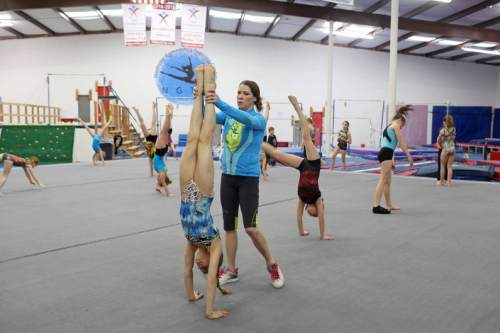By ALEXANDRA BERZON And MARK MAREMONT
April 24, 2015 5:30 a.m. ET
Natasha Hallett was a longtime performer at Cirque du Soleil, playing a key role in the circus giant’s La Nouba show in Orlando, Fla. Then she made a mistake.

Natasha Hallett, a former performer at Cirque du Soleil, was injured on the job in 2007 and is now a gymnastics trainer in Nashville, Tenn. PHOTO: Josh Anderson, Wall Street Journal
Ms. Hallett says she forgot to put a double loop through her harness for a flying trick, and a colleague didn’t notice the oversight during a safety check. She tumbled about 40 feet to the stage during a Cirque performance, shattering 19 bones from the waist down. “Like a horse that broke its leg, once you are injured you are pretty much no good for them anymore,” Ms. Hallett said.
Artists at Cirque du Soleil put their unusually adept bodies at risk to entertain audiences, just as many professional athletes do. But unlike many pro athletes, Cirque performers don’t get special treatment, such as continuing to receive regular pay, if they suffer severe injuries.
Instead, most of them are treated like ordinary workers, thrust into a complex workers’ compensation system that provides limited recompense for lost wages and permanent disabilities.
A small number of injured workers whose contracts provide for it do receive extra compensation after an injury, executives said. But relying primarily on workers’ compensation payments “is the best solution in terms of management,” Cirque spokeswoman Renée-Claude Ménard said. The company declined to comment on specific cases of injury.
For a Cirque worker injured in a major accident, the aftermath is a rarely publicized aspect of the stunning stunts that Cirque has turned into an $850-million-a-year business.
“Pain is everything for your life,” Artur Dashkevich, a former Cirque performer from Belarus, said a doctor once told him. He became permanently disabled after injuring his neck in a 2007 training accident in Montreal. He returned to Belarus, but said he can’t work and lives on about $21,000 a year from the Quebec workers’ compensation system. Others have taken jobs such as driving taxis or cutting hair while their bodies remain in pain.
Cirque executives said 80% to 90% of its performers’ injuries involve soft-tissue damage such as muscle or joint strains that accumulate over time and aren’t linked to a major accident or a single career-ending event.

Natasha Hallett looks through old photos. She started at Cirque in 1992 just after competing in the Olympics. At the time of her injury in 2007, she was making about $150,000 a year.
But Cirque stands out for the number of injuries to its performers, many of which become workers’ compensation claims. A Wall Street Journal analysis showed that in 2011, the most recent year for which data is available, Cirque’s Kà show in Las Vegas had a higher rate of injury than all but 78 workplaces on a list of nearly 52,000 of the most dangerous compiled by the U.S. Occupational Safety and Health Administration.
Nicolas Panet-Raymond, Cirque’s head of safety, said that some circuses classify their performers as contractors, which means they don’t have to provide any injury insurance coverage for them. By contrast, Cirque considers its performers employees. That means, he said, that in most places where it operates, the state or country requires the company to pay for workers’ compensation insurance so that workers can get money and health care if they are injured.
Workers’ compensation laws vary widely, but they generally prevent workers from suing their employer for negligence.
‘Pain is everything for your life’
—Artur Dashkevich, a former Cirque performer, said a doctor once told him

Natasha Hallett and her boyfriend John Baskett with their children Jacob, 3, and Ryder, 1, at their home in Nashville, Tenn.
What that formula didn’t take into account was that Ms. Hallett needed far more than normal use of her ankle to do a job in her field. “What we’re doing is a little bit more advanced than just trying to get back to walking,” she said.
She was offered $45,000, she said. After disputing the decision she settled for $170,000, a large amount in Florida, according to workers’ compensation attorneys there.
Mr. Panet-Raymond agreed the system is problematic. “Workers’ comp has not been established for high performers,” he said. “We cannot ask workers’ comp to build scales to represent our specific nature.”
Most top professional sports teams, including Major League Baseball, which are among the only workplaces to come close to Cirque in likelihood of injuries, give workers their full salary until their multiyear contracts expire. In the National Football League, injured players receive only a portion of their salary for a few years if they can’t play, but they generally receive large upfront bonus payments to make up for the risk, according to sports agents and lawyers.
Ms. Muller criticized Cirque for not providing more generous financial settlements. “These are not flukes, these are accidents,” she said. “You can’t send people home broken and broke.”
{ SOURCE: Wall Street Journal | http://goo.gl/mcg96o }